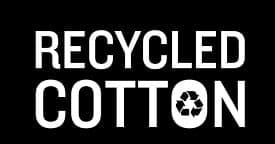Sustainability continues to be at the forefront of product decisions, brand initiatives, and strategic planning in the textile industry. The use of recycled materials, including recycled cotton, is a growing topic of interest within the sustainability umbrella. Recycled cotton is not a new concept to the textile and apparel market, but as manufacturers, brands and retailers continue to evaluate their supply chain footprint, the interest in recycled cotton has grown.
WHAT IS RECYCLED COTTON?
Recycled cotton can be generally defined as converting cotton fabric into cotton fiber that can be reused in textile products. Recycled cotton is also commonly referred to as regenerated cotton, reclaimed cotton or shoddy. Recycled content includes recycled raw material, as well as used, reconditioned, and re-manufactured components. Textile recycling is generated from two primary sources:
- Pre-consumer: includes scraps created by yarn and fabric by-products
- Post-consumer: includes garments, upholstery, towels, household items to be repurposed
The largest volume of recycled cotton sources is produced through pre-consumer waste, such as cutting scraps. Post-consumer waste is more difficult to sort through due to various color shades, fabric blends, and it is generally a more labor-intensive process.
THE PROCESS TO TURN FABRIC BACK INTO FIBER
The majority of recycled cotton is claimed through mechanical recycling. First, fabrics and materials are sorted by color. After sorting, the fabrics are run through a machine that shreds the fabric into yarn and further into raw fiber. This process is harsh and puts a great deal of strain on the fiber – it is not uncommon for fibers to break and entangle during shredding. The raw fiber is then spun back into yarns for reuse in other products. The quality of recycled fiber will never have quality values equal to the original fiber. Specifically, fiber length and length uniformity will be impacted, which will limit the end-use application.
BENEFITS & CHALLENGES TO RECYCLED COTTON FIBER
There can be many benefits with using recycled cotton, as well as some challenges.
Benefits
- Recycled cotton can find new life in many different low grade products such as insulation, mop heads, rags, and stuffing.
- The process of recycling can divert many products from landfills. According to the Council for Textile Recycling, annual textile waste is estimated to equal 25 billion pounds.1
- The amount of energy, water, and dye use is reduced from using a product that has already been processed. The savings are achieved through offsetting production of new materials. Since recycled cotton yarns most commonly are sourced from pre-consumer textile scraps that are sorted by color, the yarns are already dyed.
- The CO2 and fossil fuel emission savings can be partially offset from using existing materials. However, the collection, processing and shipping of cotton scraps or clothing can reduce or neutralize some of these savings.2
Challenges
- Cotton must be blended with other fibers to be made into new yarn for strength and durability, and therefore cannot continuously be recycled.
- The content of recycled cotton will depend on end-use application. Any amount of recycled product will impact the yarn and fabric properties such as evenness, strength, and uniformity.
- Recycled yarn cost is generally higher than standard, virgin cotton yarn costs, and could possibly be cost-prohibitive.
- Testing instruments are made for ginned, virgin cotton. Sometimes, testing results can be skewed due to the difference in fiber packing and orientation.
- The risk of contamination by other fibers is much higher for recycled cotton. Stitching, sewing thread, small amounts of spandex should all be taken into account when establishing the recycled supply chain

